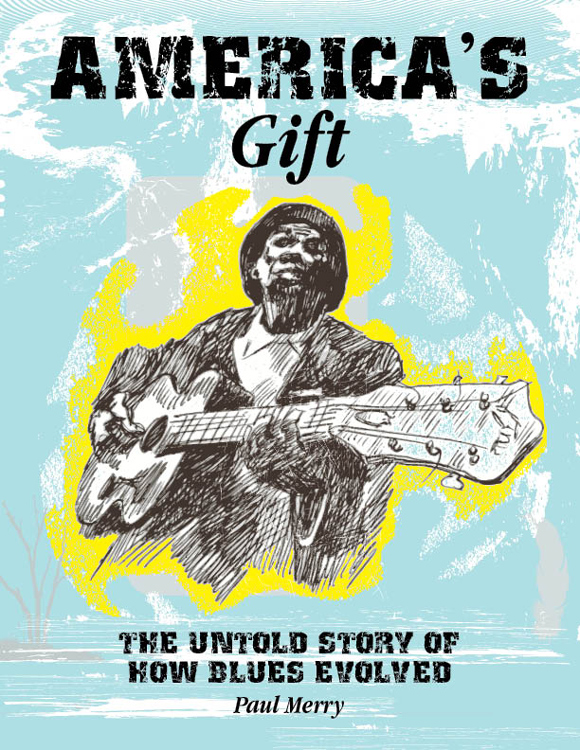MANY books and countless articles have been written about the blues but only a few authors have dug really deep into the roots of the music to discover its origins.
Until now, that is. For Australian musicologist and author Paul Merry has produced what is arguably the definitive book on the genre with his book America’s Gift: The Untold Story of How Blues Evolved (Amazon £12.95).
Merry is a leading authority on blues and jazz. And he is, without doubt, a music detective who has left no stone unturned in his quest to find the beginnings of the art form that, over the last century, has single-handedly changed the listening habits of this planet.
Down the years, I have read a great deal about this music form. But in a lifetime of study, writing about, and playing the blues, I have never come across an author with such an eye for forensic detail.
Bit by bit, he dissects, examines and then re-examines the evidence, places it all under the literary microscope, and then – and only then – announces his conclusions.

Merry may not exactly be the Sherlock Holmes of blues, but he’s certainly a latter-day musical Columbo, only clad in a loud zoot suit fit for a Saturday night jukejoint rather than that trademark shabby mac.
His analysis of the music’s journey from field to concert hall is compelling. For example, Charlie Patton is widely regarded as the Father of the Delta Blues, the starting point of the story, along with W C Handy, about whom whole oceans of ink have been expended down the years.
But who taught Patton his trade? Why, one Henry Sloan, that’s who. Think about it – Patton’s style didn’t come from nowhere. There had to be an egg before the chicken, right?
Merry also posits some interesting theories. For example, why have blues writers virtually ignored Lonnie Johnson? The author reasons that researchers in the last century tended to concentrate on ‘primitive’ blues, championing rural players such as Mance Lipscomb and Mississippi Fred McDowell, and thereby neglecting the more sophisticated players such as Johnson. Well-intentioned snobbery? Perhaps.
Merry correctly identifies the latter as being the founding father of electric guitar blues, the trailblazer who perfected the single and double string slur, later to be adopted by T-Bone Walker, the three Kings, and finally by future 1960s rock gods such as Clapton, Beck and Hendrix.
Here we have a writer with an encyclopaedic knowledge of the subject. This book runs to nearly 400 pages, yet the narrative never once stalls, because its creator has a solid background in music journalism and copywriting, in both Britain and Australia, his adopted country.
He certainly knows how to turn a phrase. And there are indeed a lot of fascinating phrases being turned here.
Every page is packed with one revelation after another, a plethora of facts and dates that will keep all blues lovers happy. The author approaches the story sequentially, from chronicling the work songs of the Antebellum South and touring ‘black face’ minstrelsy, to the more racially vicious ‘coon’ song period, then examines the great African-American migrations north in the early 20th century.
Intriguingly, he finds that the blues not only shares a kinship with the sea shanty, but also with the bawdy shower room rugby song, too.
Far-fetched? Not at all. Bearing in mind the innovative double entendres that spice up many a blues lyric, it sort of makes sense, does it not?
Merry also looks at the ‘halfway house’ style of musicians like Memphis Minnie, before tracing the advent of the Chicago variant that would lead to the rise of artists such as Muddy Waters, Little Walter and Memphis Slim, men who in turn would influence a generation of British rockers.
But the male of the species certainly don’t hog all the glory, for Merry devotes much space to the women pioneers. Ma Rainey, Bessie Smith, Sophie Tucker and Sippie Wallace are just a few who strut, shout and holler across these glorious pages, taking their musical battering rams to the walls of racism, Jim Crow laws, segregation and male supremacy.
There are indeed many precious stones to be unearthed on every page. One such gem is the grossly overlooked and under-rated Eddie Durham, who Merry identifies as being the first musician to lay down an electric guitar track in 1929.
Then there’s the little known George Barnes, virtually the only Caucasian player of note in the book, and a gargantuan talent that has in the main been ignored by most commentators and music historians.
Packed with rare photographs, America’s Gift is right up there with classic books such as Paul Oliver’s 1960s ground-breaking Conversation with the Blues, and richly deserves to be regarded in years to come as a classic work that documents the beginnings of what was destined to become the world’s most influential music form.


